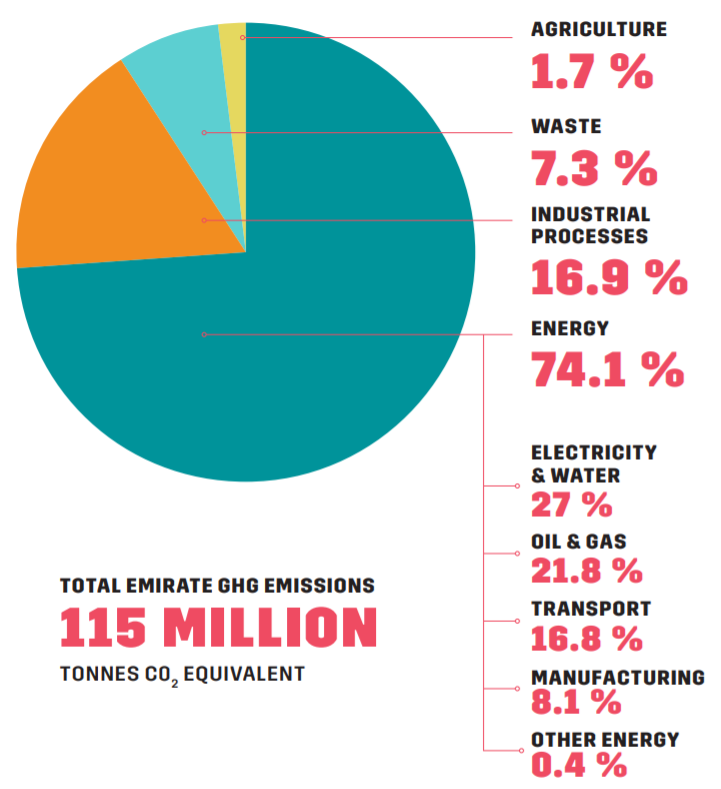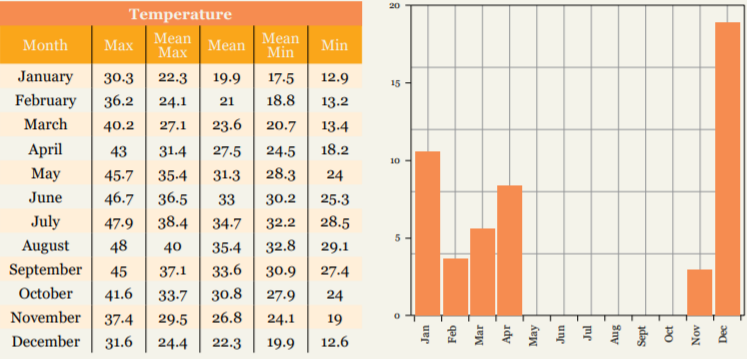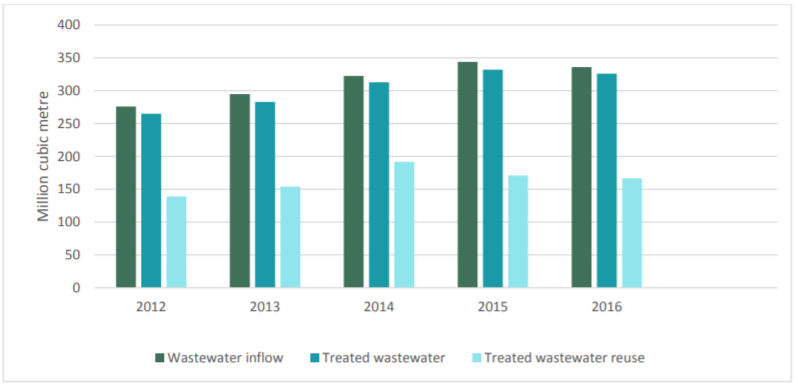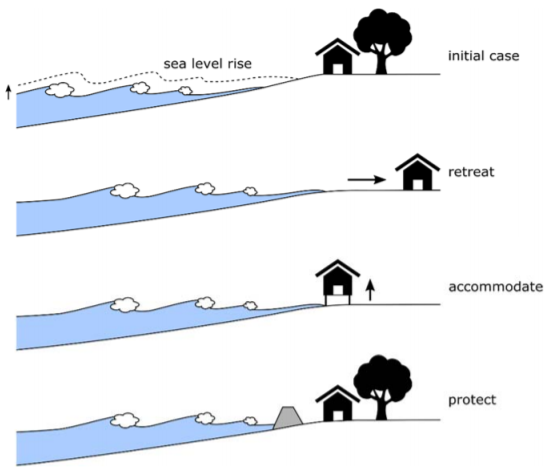Introduction
The signs of climate change have become evident, the most noticeable of them being the worldwide average temperature rise. Organizations monitoring climate change assert that even if humanity stops all its greenhouse gases (GHG) emissions, the risen temperatures will remain, as well as sea-level rise due to the irreversible ice cap loss (Hunt et al., 2018). Concurrently with climate change, the share of the world urban population is constantly increasing, from 30% in 1950 to 54% in 2014 and projected 66% in 2050 (Grafakos et al., 2018). Hence, it is the primary responsibility for cities’ authorities and other stakeholders to alter the built environment to mitigate climate change and adapt cities to its effects. This paper aims at discussing multiple challenges faced by Abu Dhabi City in the UAE because of global warming, including sea-level rise, heatwaves, air pollution and water shortage. Further, a climate change mitigation and adaptation plan for this city will be proposed, with such measures as green and white roofs, seawalls, green infrastructure and wastewater use. The implementation of this plan will bring the city environmental, economic, and social benefits.
Challenges Faced by Abu Dhabi City
Abu Dhabi is the capital city of the UAE and the Abu Dhabi Emirate and is located on a triangular island in the Persian Gulf. Abu Dhabi demonstrates the stable growth of the city population, which increased from 1.26 million people in 2010 to 1.8 million people in 2016 (Statistics Centre Abu Dhabi [SCAD], 2019). For the small territory of the city, it is a large number of inhabitants, so the population density in Abu Dhabi reaches 164 persons per square kilometre (SCAD, 2019). Figure 1 shows the distribution of the population density by areas of the city.

The building types in Abu Dhabi City differ from district to district, reflecting different stages of urban development. The Central Business District is characterized by “high-density city blocks from the mid-1970s with up to 18 storeys” (LSE Cities, 2017, p. 22). The south-western part of this district and Al Maryah and Reem Island are occupied with high-rise buildings (LSE Cities, 2017). The built environment of the remaining part of the city includes villas, hospitals, and various government buildings, and the southern side of the island is occupied by palace neighbourhoods (LSE Cities, 2017). Villa is one of the most popular building types in Abu Dhabi City, and villa districts are situated in the entrance of the city island (Bande et al., 2019). There are also low-density suburban areas that have been developed recently. While expatriate workers tend to live in high-density areas because they are close to business districts of the city, Emiratis inhabit predominantly suburbs (LSE Cities, 2017). Thus, the built environment in Abu Dhabi City varies depending on the district.
As for the design of the Abu Dhabi buildings, they are inefficient when it comes to water and energy consumption. High-rise buildings with large glass facades that have been constructed recently are not designed to meet the needs of citizens in a hot and arid climate (EWS-WWF and Acclimatise, 2017). Since the materials used for the construction were chosen for aesthetics rather than environmental performance, it resulted in high consumption of water and energy for operating such buildings. The inefficiency of buildings, in its turn, has led to high levels of GHG emissions, the main sources of which are shown in Figure 2.

The city of Abu Dhabi has a highly developed transport infrastructure. It provides many parking places and has a high road capacity (LSE Cities, 2017). In 2017, Abu Dhabi won the international TomTom Traffic Index Award with the congestion index of 14, which is among the lowest indexes worldwide (Pennington, 2017). At the same time, walking facilities in the city are poor, which makes citizens highly dependent on their cars (LSE Cities, 2017). As a result, transport infrastructure makes a large contribution to GHG emissions in Abu Dhabi. The study by Alzard et al. (2019) showed that, during the operation phase of Abu Dhabi roads, vehicle movement contributes to 81-97% of emissions. Another problem with transport infrastructure is street lights that are mostly “high-pressure sodium or metal halide” (Dennehy, 2017, para. 3). Such light fixtures contribute to 1-12% of GHG emissions during road operation (Alzard et al., 2019). Although Abu Dhabi authorities intended to replace these street lights in 2017, the project is still under development in 2020 (The National, 2020). Thus, a highly developed transport infrastructure is a large source of GHG emissions in Abu Dhabi.
Abu Dhabi is situated in an extremely arid region, and the environment becomes even harsher due to climate change. The weather pattern is characterized by hot temperatures, ranging from a minimum of 20℃ in winter to a maximum of 48℃ in summer (Figure 3) (EWS-WWF and Acclimatise, 2017). Rainfall is scanty and inconsistent, with most of the precipitation occurring between December and April (EWS-WWF and Acclimatise, 2017). It has been observed that, for the last 100 years, the maximum monthly temperature has increased by up to 1℃ (EWS-WWF and Acclimatise, 2017). In June 2017, in Sweihan, a town not far from Abu Dhabi City, the maximum temperature reached 50.4℃, setting a new record in the region (Broom, 2019). As a result of rising temperatures and low precipitation levels, the city suffers from heatwaves that are going to be more severe over time. Abu Dhabi, being a densely-populated city with high energy consumption, also experiences such an effect as urban heat island (UHI), when temperatures in a city are higher than those in rural areas (ARUP, 2018). Unless climate change mitigation and adaptation measures are taken, the city risks becoming uninhabitable.

Due to the arid climate, Abu Dhabi City experiences a lack of water supply. The city is highly dependent on desalination plants that account for about 80% of water supply (LSE Cities, 2017). Green areas in Abu Dhabi are mostly irrigated using groundwater, which is a scarce and non-renewable resource (Environment Agency – Abu Dhabi, 2017). The use of groundwater for irrigation aggravates water shortage in the city and the entire emirate and causes a conflict between the need for green infrastructure and the demand for scanty water supplies that comes from other industries.
One more challenge faced by Abu Dhabi City because of climate change is sea-level rise. Researchers report that there is “evidence of relative sea-level rise of 2.2 mm (± 0.5 mm) per year between 1979 and 2007” (Environment Agency – Abu Dhabi, 2017, p. 112). It has been predicted that, by the year 2100, the Abu Dhabi coastline is likely to retreat by 2.2-3.8 km (Bardsley, 2018). Since the majority of Abu Dhabi residents live close to the coast, rising sea levels threaten their houses and the city’s infrastructure.
Plan of Mitigation and Adaptation
As is seen from the previous section, a climate change mitigation and adaptation plan for Abu Dhabi should address such issues as heatwaves, scarce water supply, sea-level rise, and air pollution due to GHG emissions. As a rule, mitigation measures are those intended to reduce GHG emissions, thus targeting the cause of climate change, and adaptation measures are those designed to decrease the impact of global warming on people, thus focusing on the climate change consequences (Grafakos et al., 2018). The plan should avoid conflicts between adaptation and mitigation, which may result from implementing such measures as air conditioning that reduces heat but leads to increased energy consumption and, consequently, GHG emissions.
Heatwaves
To address the problem of heatwaves and UHI, Abu Dhabi should consider the use of cool roofs. There are two ways of changing roofs to reduce heat: green roofs and cool roofs. The first option is a roof covered with vegetation, which is a suitable choice for areas with intense rainfall events (Shalaby and Aboelnaga, 2017). The second option means a roof covered with paint or material with a high albedo, so it reflects more solar radiation than absorbs. A case study of Melbourne, Australia, for which researchers modelled the impact of green and cool roofs during an extreme heatwave, showed that cool roofs are more effective than green ones in hot and arid climate (Imran et al., 2018). While green roofs could decrease the UHI effect at the roof surface by 1.15-3.8℃, cool roofs reduced the temperature by 2.2-5.2℃ (Imran et al., 2018). Since the climate in Melbourne and Abu Dhabi have similar features, cool roofs will probably be a preferable option in terms of efficiency. Another justification for choosing cool roofs rather than green ones is water scarcity in Abu Dhabi, which may hinder the maintenance of roof vegetation.
The use of cool roofs for buildings in Abu Dhabi was also recommended by a recent study. Bande et al. (2019) evaluated various measures for reducing the UHI effect in Abu Dhabi villas and concluded that cool roof, apart from lowering the temperature, could decrease the annual energy consumption by 3.85%. Even more reduction of energy use (8.4%) could be achieved by adding cool paint to walls of a villa (Bande et al., 2019). While cool roofs are a preferred adaptive measure for households, it may be supplemented by green infrastructure at a city scale to reduce the UHI effect more considerably (Welz et al., 2018). Table 1 shows the decrease in air temperature depending on the green-white adaptation ratio in the case study of “Villa Peru,” La Florida, Chile.

(Source: Welz et al., 2018, p. 333).
Although Abu Dhabi is located in an arid area, it still has to develop green infrastructure to reduce the UHI effect. Emilsson and Ode Sang (2017) suggest that cities with short water supplies should carefully decide on planting design and the type of vegetation. Trees planted at 7.5 m distance, combined with bare soil or porous pavements, reduce air temperature efficiently and require little water (Emilsson and Ode Sang, 2017). As for the type of vegetation, xeric trees are suitable for arid regions since they decrease the UHI effect, give shade and are resistant to dry climate (Emilsson and Ode Sang, 2017). According to Emilsson and Ode Sang (2017), green infrastructure should be concentrated in densely-populated areas. For Abu Dhabi, such areas were shown in Figure 1.
The case study of the city of Basel in Switzerland provides an example of how the government can encourage citizens to adopt climate change adaptations. To motivate residents to install green roofs, the city authorities offered a subsidy to equalize the cost of conventional and green roofs and passed an amendment to the construction law, according to which all new roofs had to be greened (European Environment Agency [EEA], 2018). As a result, the number of green roofs per capita in Basel has become one of the largest in the world, and constructors have gained experience in installing them (EEA, 2018). Abu Dhabi authorities should also consider passing new laws and policies to encourage adopting cool roofs and green infrastructure.
Air Pollution
Adding vegetation to the city’s built environment, which is described in the previous section, will also address the problem of air pollution. Green areas serve both as a climate change mitigation and adaptation measure. Trees absorb a portion of greenhouse gases, thus responding to the consequences of anthropogenic emissions. At the same time, green infrastructure decreases air temperature and, consequently, reduces the need for air conditioning, which results in decreased energy consumption and GHG emissions.
However, Abu Dhabi has to implement at least one more measure to reduce air pollution by GHG emissions. As was mentioned earlier, the city’s high-pressure sodium street lights, which are part of transport infrastructure, are a source of GHG emissions. A sustainable solution to this problem is replacing inefficient lamps with light-emitting diodes (LEDs). The case study of Cracow, Poland, shows that using LEDs instead of high pressure sodium lamps led to a 41% reduction of GHG emissions (Sedziwy, Basiura and Wojnicki, 2018). An adaptive lighting control system contributed to a 14% more reduction (Sedziwy, Basiura and Wojnicki, 2018). Apart from environmental benefits, roadway lighting retrofit allowed the city to increase annual savings by reducing CO2 emissions and decreasing energy consumption. It has been estimated that replacing street lights in the entire Abu Dhabi Emirate will result in the savings of 900 million kilowatts over 12 years (The National, 2020). Given the estimated benefits and the successful example of Cracow, Abu Dhabi City should implement this mitigation measure.
Scarce Water Supply
To address the problem of water shortage, Abu Dhabi should consider regulating water usage of industries and increasing the use of recycled water. For example, in the Haihe River basin in China, authorities increased water prices and introduced water quotas to manage water demand (Wang et al., 2016). As a result, agricultural areas decreased but developed efficient ways of irrigation, and the industrial sector began to consume less water due to adopting water-efficient technologies (Wang et al., 2016). In Antofagasta, Chile, a city with annual rainfall reaching only 1 mm, recycled water is used for irrigating plants constituting the city’s green infrastructure (ARUP, 2018). Since Abu Dhabi has scarce water supply and currently uses groundwater to irrigate plants, the city should adopt the proposed measures to improve its green infrastructure and manage water demand. Figure 4 shows that Abu Dhabi has the potential to increase its wastewater reuse.

Sea Level Rise
Abu Dhabi should adapt to sea-level rise by constructing seawalls along the coast. Seawalls ensure the stability of the coastal structure and serve as an alternative adaptation measure to a managed retreat of the population and infrastructure inland or accommodation (Figure 5). This option is preferred to others because Abu Dhabi has a highly developed coastal infrastructure, and most of its population lives close to the shore, so it is more reasonable to pursue protective measures. The case study of Timmendorfer Strand in Germany shows that seawalls can preserve the city’s attractiveness to tourists if they are designed according to the community’s needs (EEA, 2018). The estimated benefits of coastal flood defence of Timmendorfer Strand appear to outdo costs by 4-8 times (EEA, 2018). Hence, seawalls in Abu Dhabi can be a cost-effective way of protecting coastal areas from flooding due to sea-level rise.

Stakeholders
The adoption of the discussed climate change mitigation and adaptation measures requires the participation of a great number of stakeholders. The role of local authorities is to initiate changes that can be performed by individual actors (Baranka et al., 2016). They should appoint an appropriate local government body that would organize and oversee the implementation of the plan (Baranka et al., 2016). Local authorities are also responsible for motivating and persuading citizens to take measures to mitigate and adapt to climate change. Finally, the participation of such international systems as “the UN’s Clean Development Mechanism (CDM), the Adaptation Fund, the Green Carbon Fund (GCF) or the World Bank’s Green Environment Fund (GEF)” may be helpful (Lambert and D’Alessandro, 2019, para. 19). They provide resources for sustainable development, but the Arab countries, including the UAE, use little of this aid.
Environmental, Social and Economic Benefits of the Proposed Plan
Environmental benefits of the proposed plan include the reduction of GHG emissions due to roadway lighting retrofit and energy saving resulting from the introduction of cool roofs and green areas. Reuse of wastewater contributes to such ecological benefits as preserving coastal ecosystems and developing green infrastructure and social benefits, including preventing the use of drinking water for irrigation and increasing people’s well-being with green spaces (Spencer et al., 2016). The economic benefits of the provided plan include cost saving due to more efficient energy and water consumption. Moreover, since heatwaves cause economic losses due to people’s illnesses or deaths that result in the reduction of working hours, measures mitigating the impact of high temperatures may lead to economic benefits (Xia et al., 2018). If citizens experience morbid conditions because of heatwaves more rarely due to adaptation measures, they will be able to produce more economic output.
Conclusion
Abu Dhabi City faces many challenges because of climate change, including heatwaves and the UHI effect, sea-level rise, air pollution, and water shortage. The city should pay attention to such mitigation and adaptation measures as cool roofs, green areas irrigated by recycled water to preserve scarce water supplies, roadway lighting retrofit and seawalls. This plan will allow the city to reduce air temperature and improve air quality, as well as enhance citizens’ health and access to drinking water and preserve coastal areas. The economic benefits of this plan consist mainly in saving costs due to reduced energy consumption and maintaining the working capacity of the labour force.
Reference List
Alzard, M. H. et al. (2019) ‘Estimation of greenhouse gas emissions produced by road projects in Abu Dhabi, United Arab Emirates’, Sustainability, 11(8), pp. 1-16.
ARUP (2018) Cities alive: rethinking cities in arid environments. Web.
Bande, L. et al. (2019) ‘A building retrofit and sensitivity analysis in an automatically calibrated model considering the urban heat island effect in Abu Dhabi, UAE’, Sustainability, 11(24), pp. 1-18.
Baranka, G. et al. (2016) ‘Pilot action in Budapest’, in Musco, F. (ed.) Counteracting urban heat island effects in a global climate change scenario. Cham: Springer, pp. 345-372.
Bardsley, D. (2018) Abu Dhabi coastline could retreat by year 2100 due to rising sea levels. Web.
Broom, D. (2019)How the Middle East is suffering on the front lines of climate change. Web.
Dennehy, J. (2017) The big switch: Abu Dhabi’s plan to convert old lights to LEDs. Web.
Emilsson T. and Ode Sang, Å. (2017) ‘Impacts of climate change on urban areas and nature-based solutions for adaptation’, in Kabisch N. et al. (eds.) Nature-based solutions to climate change adaptation in urban areas. Cham: Springer, pp. 15-27.
Environment Agency – Abu Dhabi (2017) Abu Dhabi state of environment report 2017. Web.
Environmental Atlas of Abu Dhabi Emirate (no date) Abu Dhabi City population density.Web.
European Environment Agency (2018) Climate-adapt: 10 case studies how Europe is adapting to climate change. Luxembourg: Publications Office of the European Union.
EWS-WWF and Acclimatise (2017) UAE climate change risks & resilience: an overview of climate change risks to 12 key sectors. Web.
Grafakos, S. et al. (2018) ‘Integrating mitigation and adaptation: opportunities and challenges’, in Rosenzweig, C. et al. (eds.) Climate change and cities: second assessment report of the urban climate change research network. New York: Cambridge University Press, pp. 101-138.
Howe, D. and Cox, R. J. (2018) Guidelines for seawall adaptation: science and synthesis for NSW. Web.
Hunt, J. C. R. et al. (2018) ‘Climate change and growing megacities: hazards and vulnerability’, Engineering Sustainability, 171(6), pp. 314-326.
Imran, H. M. et al. (2018) ‘Effectiveness of green and cool roofs in mitigating urban heat island effects during a heatwave event in the city of Melbourne in southeast Australia’, Journal of Cleaner Production, 197(1), pp. 393-405.
Lambert, L. A. and D’Alessandro, C. (2019) Climate change, sea level rise, and sustainable urban adaptation in Arab coastal cities. Web.
LSE Cities (2017)Resource urbanism: Asia’s divergent city models of Kuwait, Abu Dhabi, Singapore and Hong Kong. Web.
Pennington, R. (2017) Abu Dhabi wins best traffic infrastructure award. Web.
Sedziwy, A., Basiura, A. and Wojnicki, I. (2018) ‘Roadway lighting retrofit: environmental and economic impact of greenhouse gases footprint reduction’, Sustainability, 10(11), pp. 1-11.
Shalaby, H. and Aboelnaga, S. (2017) ‘Climate change impacts on urban planning in the cities’, Proceeding of the 1st international conference: towards a better quality of life, Technische Universität Berlin, El Gouna, Egypt, 24-26 November. Web.
Spencer, B. et al. (2016) ‘Case studies in co-benefits approaches to climate change mitigation and adaptation’, Journal of Environmental Planning and Management, 60(4), pp. 1-21.
Statistics Centre Abu Dhabi (2019) Statistical yearbook of Abu Dhabi 2019. Web.
Statistics Centre Abu Dhabi (2017) Environment statistics 2016. Web.
The National (2020) Abu Dhabi awards contract for major LED street light project. Web.
Wang, X. et al. (2016) ‘Adaptation to climate change impacts on water demand’, Mitigation and Adaptation Strategies for Global Change, 21(1), 81-99.
Welz, J. et al. (2018) ‘Adapting built–up areas to climate change: assessment of effects and feasibility of adaptation measures on heat hazard’, in Kabisch, S. et al. (eds.) Urban transformations. Cham: Springer, pp. 327-338.
Xia, Y. et al. (2018) ‘Assessment of the economic impacts of heat waves: a case study of Nanjing, China’, Journal of Cleaner Production, 171, pp. 811-819.